Discover the Heartwarming Comfort of Hoto
Hoto is not just a dish; it’s a slice of history simmered in a pot. Hailing from the scenic Yamanashi Prefecture, located near Tokyo, this delicious udon noodle stew boasts a lineage steeped in mystery and tradition. Believed to be mentioned in the ancient Pillow Book from the Heian era (794-1185), the exact origins of Hoto remain elusive. However, captivating tales surrounding this comforting meal are rich with collective truths.
One popular theory suggests that the name “hoto” is derived from an ancient Chinese cake known as hakutaku. In fact, the dish referenced in the Pillow Book might have actually been this dumpling-like delicacy made from wheat flour. Thus, for a time, many wheat-based dishes were affectionately called hoto.
Another intriguing possibility stems from the harsher realities faced by farmers during Japan’s Edo period (1603-1867). Despite being part of the second-highest social class, farmers were forbidden from consuming rice, wheat, or soba (buckwheat noodles). All these staples were instead appropriated as tax, which the aristocracy enjoyed. Nowadays, it’s hard to imagine when farmers enjoy such prominence and power in society, but at that time, they were almost powerless. A prevalent saying in those days was, “Let the farmers neither live nor die.”
In this context, one narrative emerged: desperate to avoid scrutiny from government overseers, farmers would hide their wheat and refer to their dishes as hatto or hattoh, translating to “prohibition.” These names were a clever ruse, often applied to dumpling soups or wide soba varieties.
Another angle is that the wheat prohibition was so effective it hindered hoto’s popularity until the Taisho era (1912-1926), long after restrictions had eased. Eventually, Yamanashi locals began enjoying a type of hoto for dinner, sometimes reserving hardened leftovers to scoop atop rice for breakfast the following day.
A much-loved ingredient in authentic Yamanashi hoto is pumpkin. I personally adore using kabocha, a sweet variety of Japanese pumpkin that served as a natural sweetener back when sugar was scarce. In the mountainous region of Yamanashi, this delicious dish was once considered gourmet fare.
True to its roots, authentic hoto features handmade udon noodles, which are crafted without salt and cooked fresh, yielding a delectably chewy texture. However, if you prefer convenience, fresh store-bought udon noodles are perfectly acceptable—just be mindful not to overcook them; they should retain a slight bite.
My version of this dish is brimming with umami, incorporating pork, but feel free to substitute in chicken or wild boar, or even tofu for a vegetarian twist. Not to mention, the addition of various vegetables like mushrooms, daikon radish, carrots, burdock root, taro, and fried tofu pockets (aburaage) can elevate the stew even further. Modern adaptations might even venture to incorporate ingredients like curry or butter for added richness—a splurge I personally enjoy for this flavorful dish! With autumn rolling in and cooler weather arriving, hoto stands out as one of my go-to comfort meals. Hearty, satisfying, and versatile, it’s a delightful one-pot offering!
Ingredients
- 1/2 lb lean, thinly sliced pork
- 3/4 lb kabocha (Japanese pumpkin, skin on), washed, seeded, and thinly sliced into half-moon shapes
- 1 package enoki mushrooms, washed and stemmed
- 1 Japanese leek (white part only), well-washed and coarsely chopped
- 2 tbsp butter (or substitute with neutral oil)
- 5 cups homemade dashi (fish) stock or water
- 4 tbsp miso paste (2 tablespoons red and 2 tablespoons white, or to taste)
- 10-1/2 ounces fresh udon noodles
For Garnish
- 2-3 tbsp peeled fresh ginger, cut into slivers
Instructions
Prepare the Base
In a deep medium-sized pot, briefly sauté the pork, pumpkin, mushrooms, and chopped leek in butter until they begin to soften. Pour in the dashi or water and bring everything to a rolling boil. To incorporate the miso consistently, mix it with a bit of broth in a separate bowl before adding it to the pot. Reduce the heat to a high simmer and let the mixture cook for about 15 minutes. You’ll know it’s ready when you can easily pierce the vegetables with a fork.
Add the Noodles
Introduce the udon noodles into the pot. Continue cooking for an additional 5 minutes or until the noodles reach your desired level of doneness; they should still have a slight chewiness to them.
Serve and Enjoy
Dishing out the Hoto is the most delightful part! Serve hot in generous soup bowls topped with fresh ginger to enhance the flavor.
Notes
The beauty of Hoto lies in its adaptability; consider adding your favorite vegetables to the pot! Onions and potatoes, for example, can easily enhance the dish.
Here are a few additional ideas to experiment with:
- Aburaage (fried tofu pockets): Quick boil these to remove excess oil, then slice them thickly.
- Your favorite mushrooms: While I love using shimeji, shiitake, and enoki, feel free to mix in any mushrooms you enjoy.
- Satoimo (taro): These need peeling and rinsing before cutting into halves or quarters—add them when you sauté the other ingredients.
- Burdock Root (Gobo): My friend Naomi suggested this delightful addition. Peel the gobo, slice it on the bias into thin rounds, and sauté it in a little oil in the pot until it caramelizes and releases its natural sweetness before proceeding with your hoto recipe.











